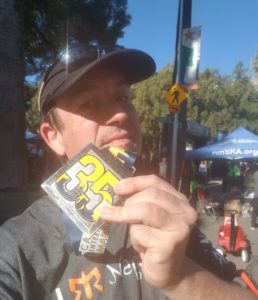I am a long distance runner. I run three to four marathons a year, along with half marathons, 10Ks, 5Ks, and the occasional Ragnar Relay. Since 2009, when I ran my first marathon in San Francisco, I’ve run a total of twenty five marathons. On my bucket list is a twelve month span in which I run one marathon a month, something I may try to achieve starting this year.
Being a slower runner brings many challenges that some other runners don’t have to face. It’s harder to schedule training runs, since it takes longer for me to pound out a 12 mile long run than a faster or “normal” runner. The physical limitations that slow me down, in my case age and extra pounds, can bring added health risks and an increase in the possibility of injury. And there’s the mental aspects: Getting burned by gazelles, the fit and lean zero percent body fatters either on the trail during training runs or during races that zoom by me, can be demoralizing and deflating. One runner friend of mine shrugged when she ran a 3:30 marathon. “Eh. It’s okay, I guess,” she said flippantly. I told her if I could manage a sub-four hour marathon I would be overjoyed.
Then there’s the comments. “You don’t look like a runner.” That is, I don’t look like an ultra-thin professional runner. Because when people think about runners they think about young six-packed abed sprinters and the professional long distance runners with sleek and sinewy drainpipe bodies. That’s what always comes to mind, which is why I also frequently get the comment, “If you run all of the time, how come you’re not really skinny?” Facing the preconception of what a runner is supposed to look like is something I often encounter.
There’s also the question of endurance. When it takes you longer to run a half or do a 16 mile training run, you’re out there a lot longer, sweating and huffing and puffing for much longer than a quicker runner would pound the pavement. But some people recognize that facet of slower runners. A marathon winner once gave props to the slower runners. He said he could not imagine running for five hours, and he didn’t know how the slower runners could do it. I’ve jokingly said that faster runners were wimps, because they only took three hours to run a marathon. I was only kind of kidding. The slower runner has to work much harder on endurance.

Running has become really popular in the United States. More and more people sign up for races, people who would have never thought to sign up for a race before. There have been complaints from “real” runners that the courses are getting clogged with plodders, with “fatties”, and with people who those “real” runners believe shouldn’t be on the course in the first place. Some of that came with a study by RunRepeat.com that showed that overall average pacing during races was slowing down, prompting some people to protest the number of tortoises entering races. The New York Times reported that “In 1980, the median finishing time for male runners in United States marathons was 3 hours 32 minutes 17 seconds, a pace of about eight minutes per mile. In 2008, the median finishing time was 4:16, a pace of 9:46. For women, that time in 1980 was 4:03:39. Last year, it was 4:43:32.”
It’s a phenomena that has prompted a lot of people to ask, when can we call someone a runner, and when are they not a runner based on their pace? Danielle Rosvally, a confessed slow runner and crossfitter from Boston, said “Us back-of-packers are so nervous that someone will kick us out of the ‘running club’ that we often never pluck up the courage to wear our club shirts proudly.”
I know I should be proud. It’s what I tell other runners. I literally know people who could not get up out of bed or off of the couch and go around the block without getting winded. And even with my beer belly and wrinkles, people are still impressed. “Wow! You run marathons?” Usually followed by “I could never do that.” Which is when I try to recruit them. “Look at me,” I will usually people who doubt themselves. “I’m old and fat. If I can do it, why couldn’t you?”

As far as my chubby self goes, I’m always striving to improve myself. I’m doing a lot more leg exercises to increase speed and reduce the chance of injury. (Hello goblet squats at home without a trainer yelling at you!) I’m trying to log more miles during the week, and sticking to a once-a-week fitness boot camp to help my overall fitness, as well as engaging in alternative cardio. The perpetual beer belly is my curse, one which I’ve been trying to address. I’ve been trying to lose more weight so I can run faster. I oftentimes forget the vanity aspect of weight loss. I’m not trying to lose weight so I can look “more like a runner”. I want a new marathon PR. I want to run a sub four hour marathon someday, if it’s possible.
Which brings me to another point. I mentioned how a friend of mine tossed off a sub four hour marathon as if it were no big deal. She’s one of the fittest and most disciplined amateur atheletes I’ve ever met. And I realize she wants to improve and perform better, just as I do. But I pointed out that her “eh” marathon would have been a dream come true for me. I don’t know for a fact that she takes her speed and abilities for granted. Perhaps sometimes she does. And that made me think that perhaps I do as well. Yeah, a sub four marathon is still out of reach for me, but it’s one I’m working towards. Even so, I run marathons. I’ve chalked up more than 650 miles of marathon running in the past nine years, and that doesn’t include all of the half, 10K, 5K, and Ragnar Relay legs I’ve grinded out, as well as all of the training miles. That I can do that at all is something I should not take for granted. And that’s the challenge: When you’re a tortoise and you’re getting run over by gazelles at yet another half marathon, remind yourself that there are so many people out there that cannot do this. And there are even so many more who do not do such things simply because they lack the willpower and discipline to do so.
As Jeff Gaudette in a Competitor Running article said, “Unless you’re Kenenisa Bekele, Mo Farah or Galen Rupp, chances are there is always going to be someone faster than you. Fast is relative.” Gaudette also remarked that thinking of yourself as a slow runer can be dertimental to your training and running life: “From a pure performance perspective, thinking negatively can inhibit you from achieving your potential… Countless research studies in sports psychology have proven the power of positive thinking and self-talk. Athletes who go into a workout or race with positive thoughts perform significantly better and more consistently than those who approach workouts and races with a negative attitude.”
In any case, so goes the conflicts. I will try to think of myself as a runner, and not a “slow” runner, which is made all the more difficult by my training schedule, the “you don’t look like a runner” comments, and the road runners that zip past me. It’s a mixed bag of pride, desire, and envy, and sometimes wishful thinking, but sometimes some of my wishes come true.
The previously mentioned Rosvally said “I continually re-examined my own logic, returning to my runner affirmations again and again. Lucky for me, it’s hard to argue with a wall full of finisher medals once you’ve seen them for what they are.”
And now it’s time to prepare myself for a new PR attempt in Calgary this May. Nice, flat course, but dry air. Hopefully I’ll hydrate just right!
And I should mention something about the title of this blog post. I’m not really a lonely slow distance runner, because at every race I have plenty of fellow tortoises and plodders to keep me company!
